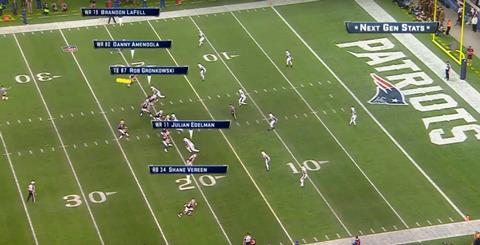Julie Souza, head of Sports, AWS Professional Services explains how NFL’s new data-driven on-screen graphics help demystify the game

American football is a complicated game. Whether you’re on the pitch, in the stands, or at home, the game is captivating because of its complexity. It rewards those who are willing to dig deep and analyse the data and insights.
Former Arizona Cardinals wide receiver Larry Fitzgerald knows the value of data. As a 17-season NFL veteran and 11-time Pro Bowler, he used statistics to gain an edge as a player. Now as a football commentator, Larry uses Next Gen Stats to help bring an in-depth understanding of the game to fans.
New functions for data-driven insights
Next Gen Stats (NGS) is a collaboration between Amazon Web Services (AWS) and the NFL, leveraging a cloud-based data strategy powered by analytics, machine learning (ML), and artificial intelligence (AI). The stats are created using real-time location data, speed, and acceleration for every player and play, resulting in data that can both create a better experience for fans, players, and teams, and improve player health and safety.
This year, Next Gen Stats also released new analysis for Expected Return Yards and for a first-of-its kind AI system that can identify eight types of man and zone defensive coverages, just seconds after a play ends.
During the Super Bowl festivities, Next Gen Stats had an additional function at the 12th Annual NFL Honors, the NFL’s awards special that recognises the best performances of the season. Next Gen Stats helped evaluate the action on the field to select Justin Jefferson’s 32-yard, one-handed catch in the Minnesota Vikings game against the Buffalo Bills as the Next Gen Stats Moment of the Year Powered by AWS.
This incredible play, which Fitzgerald described as “out of this world” and also chose as his top pick for moment of the year, had just a 28.8% completion probability according to Next Gen Stats. Jefferson ended the game with nine receptions under 50% completion probability, the most in a game in the Next Gen Stats era.
Such insights are made possible thanks to the variety of AI/ML techniques and algorithms that the AWS and NFL Next Gen Stats teams use. Together, they also leveraged existing model architectures to develop new stats. For example, the 2020 Expected Rushing Yards model was a solution designed by Austrian data scientists Philipp Singer & Dmitry Gordeev (2019 Big Data Bowl winners) that leveraged raw player-tracking data and deep-learning techniques. Two years later, the NFL and AWS have leveraged this architecture for similar solutions, including the 2021 Expected Points Added model, the primary model that drives the NGS Passing Score. Utilising the similar modelling architecture, this year AWS and the NFL developed expected yards models for the return game – Expected Punt and Kickoff Return Yards.
Making football analytics accessible
The NFL is constantly evolving, both on and off the field. One of the biggest shifts in recent years is the league’s commitment to using data and technology to improve the sport.
This includes the introduction of the NFL Big Data Bowl, which was created five years ago, to develop new insights and analytical approaches using the NFL’s Next Gen Stats data. The goal was to create an open platform for engineers, data scientists and students, with no sports experience required, and from all over the world, to get involved in football analytics.
With NFL data only recently being made publicly available, many of the ideas that come out of the Big Data Bowl are fundamentally new. Some of the most creative concepts come from people who aren’t necessarily football experts but they possess an understanding of a field like physics and are able to port that knowledge over to football.

The Big Data Bowl paves the way for new statistics. Over the last few years, a number of submissions have gone from research projects to productionized Next Gen Stats that are used during game broadcasts such as route recognition and coverage classification. AWS is proud to be a part of making the game more interesting and engaging for NFL fans.
AWS is also committed to opportunities like the Big Data Bowl that challenge aspiring data scientists and ensure that the benefits of machine learning become more widely accessible to users of all skill levels. More than 50 Big Data Bowl participants have been hired to work in professional sports analytics.
With more than 300 million data points collected each NFL season, the future of Next Gen Stats is almost limitless.

Julie Souza is head of sports, AWS Professional Services







No comments yet